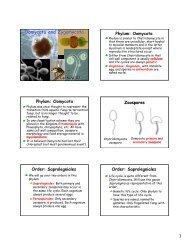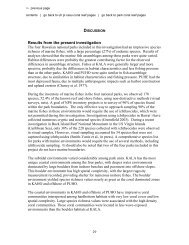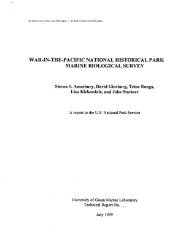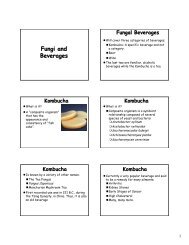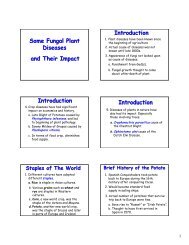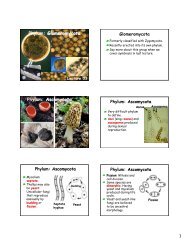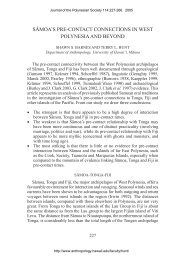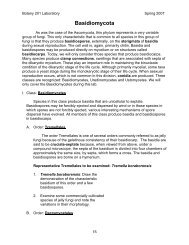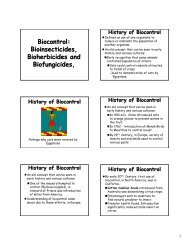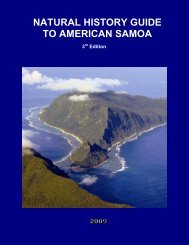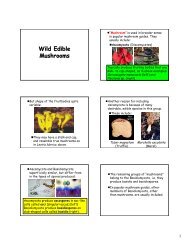american samoa - University of Hawaii at Manoa Botany Department
american samoa - University of Hawaii at Manoa Botany Department
american samoa - University of Hawaii at Manoa Botany Department
- No tags were found...
You also want an ePaper? Increase the reach of your titles
YUMPU automatically turns print PDFs into web optimized ePapers that Google loves.
The availability <strong>of</strong> new, blight-resistant cultivars <strong>of</strong> taro could enable future taro production inthe Taufusi Marsh. A project manager from the American Samoa Coastal ManagementProgram (ASCMP) would need to coordin<strong>at</strong>e project tasks in cooper<strong>at</strong>ion with the AmericanSamoa <strong>Department</strong> <strong>of</strong> Agriculture and/or the Ministry <strong>of</strong> Agriculture in Western Samoa toobtain new varieties <strong>of</strong> taro th<strong>at</strong> are resistant to the lega (taro blight).When obtained, a sample <strong>of</strong> such plants would be provided by the American Samoa CMP torepresent<strong>at</strong>ives <strong>of</strong> families holding titles to lands within the marsh. The intent <strong>of</strong> this approachwould be to:• encourage family efforts to re-establish new varieties <strong>of</strong> wetland taro within the marsh, and• enable Alao residents to test the interest <strong>of</strong> Tutuila residents to purchase and consume thesenew varieties <strong>of</strong> taro.Implement<strong>at</strong>ion <strong>of</strong> this project would initially require the excav<strong>at</strong>ion <strong>of</strong> fill m<strong>at</strong>erial in the westportion <strong>of</strong> Taufusi Marsh to a minimum soil depth <strong>of</strong> about one to two feet. Solid wastem<strong>at</strong>erial and veget<strong>at</strong>ive m<strong>at</strong>erial contained in the remaining soil m<strong>at</strong>erial will need to beremoved from the site. In terms <strong>of</strong> soil prepar<strong>at</strong>ion, the production <strong>of</strong> talo toto i le vai (wetlandtaro) will require manual and/or mechanical tilling <strong>of</strong> the soil and the possible applic<strong>at</strong>ion <strong>of</strong>some limited nutrients to the soil.Taro cuttings from disease-free propag<strong>at</strong>ing m<strong>at</strong>erial would be used to establish the taro. Thecuttings are part <strong>of</strong> a taro plant stem about 12 to 18 inches long th<strong>at</strong> is <strong>at</strong>tached to a 2 to 3-inchsection <strong>of</strong> the corm. Such cuttings would ideally be obtained from the ASG <strong>Department</strong> <strong>of</strong>Agriculture or Samoa Ministry <strong>of</strong> Agriculture in Apia. Before planting, selected taro cuttingswould be carefully inspected, washed with potable w<strong>at</strong>er, soaked in a 10 percent bleachsolution for 30 seconds, and stored in a dry, cool, and well-ventil<strong>at</strong>ed area for 3 to 5 daysbefore planting.Compar<strong>at</strong>ive Benefits and ImpactsPPC’s evalu<strong>at</strong>ion <strong>of</strong> two altern<strong>at</strong>e restor<strong>at</strong>ion and enhancement str<strong>at</strong>egies is summarized inTable 3-4. One <strong>of</strong> these opportunities, Options 2, would achieve gre<strong>at</strong>er benefits to n<strong>at</strong>uralresources and enhance opportunities for other potential wetland functions.An <strong>at</strong>tempt to restore n<strong>at</strong>ive marsh veget<strong>at</strong>ion (Option 1) would require the planting <strong>of</strong> n<strong>at</strong>ivemarsh plants such as utuutu (w<strong>at</strong>er chestnut), vao tuaniu (marsh fern), and sa<strong>at</strong>o (swamp fern).None <strong>of</strong> these marsh plants were found in the marsh in November 1999 and probably do notexist there. However, cuttings could be obtained by the ASCC Land Grant Program andplanted by program staff.The prospect <strong>of</strong> community support for this restor<strong>at</strong>ion opportunity may be limited. At leastfour families in Alao Village hold titles to the lands comprising Taufusi Marsh (Puaauli, 2000).One or more families continue to be using the east portion <strong>of</strong> the wetland for the commercialproduction <strong>of</strong> Chinese cabbage th<strong>at</strong> gener<strong>at</strong>es some household income.Wetland taro production would gener<strong>at</strong>e more desirable project benefits. Taro productionwould primarily enhance subsistence and commercial agricultural production, which isconsistent with other ongoing uses <strong>of</strong> the wetland. At the same time, taro production wouldsecondarily enhance future stormw<strong>at</strong>er detention and gener<strong>at</strong>e some increased groundw<strong>at</strong>errecharge to the basal aquifer.American Samoa Wetland/Stream Restor<strong>at</strong>ion and Enhancement PlanFebruary 2001, Alao Wetland, Page 3-11



